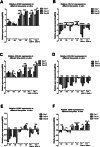Synergistic interaction of hTGF-β3 with hBMP-6 promotes articular cartilage formation in chitosan scaffolds with hADSCs: implications for regenerative medicine
- PMID: 32854680
- PMCID: PMC7457281
- DOI: 10.1186/s12896-020-00641-y
Synergistic interaction of hTGF-β3 with hBMP-6 promotes articular cartilage formation in chitosan scaffolds with hADSCs: implications for regenerative medicine
Abstract
Background: Human TGF-β3 has been used in many studies to induce genes coding for typical cartilage matrix components and accelerate chondrogenic differentiation, making it the standard constituent in most cultivation media used for the assessment of chondrogenesis associated with various stem cell types on carrier matrices. However, in vivo data suggests that TGF-β3 and its other isoforms also induce endochondral and intramembranous osteogenesis in non-primate species to other mammals. Based on previously demonstrated improved articular cartilage induction by a using hTGF-β3 and hBMP-6 together on hADSC cultures and the interaction of TGF- β with matrix in vivo, the present study investigates the interaction of a chitosan scaffold as polyanionic polysaccharide with both growth factors. The study analyzes the difference between chondrogenic differentiation that leads to stable hyaline cartilage and the endochondral ossification route that ends in hypertrophy by extending the usual panel of investigated gene expression and stringent employment of quantitative PCR.
Results: By assessing the viability, proliferation, matrix formation and gene expression patterns it is shown that hTGF-β3 + hBMP-6 promotes improved hyaline articular cartilage formation in a chitosan scaffold in which ACAN with Col2A1 and not Col1A1 nor Col10A1 where highly expressed both at a transcriptional and translational level. Inversely, hTGF-β3 alone tended towards endochondral bone formation showing according protein and gene expression patterns.
Conclusion: These findings demonstrate that clinical therapies should consider using hTGF-β3 + hBMP-6 in articular cartilage regeneration therapies as the synergistic interaction of these morphogens seems to ensure and maintain proper hyaline articular cartilage matrix formation counteracting degeneration to fibrous tissue or ossification. These effects are produced by interaction of the growth factors with the polysaccharide matrix.
Keywords: Adipose-derived stem cell; Articular Chondrogenesis; Bone formation; Chitosan; Promotion; Synergism; Validation; hBMP-6; hTGF-β3.
Conflict of interest statement
The authors declare no conflict of interest.
Figures









Similar articles
-
Induction of Articular Chondrogenesis by Chitosan/Hyaluronic-Acid-Based Biomimetic Matrices Using Human Adipose-Derived Stem Cells.Int J Mol Sci. 2019 Sep 11;20(18):4487. doi: 10.3390/ijms20184487. Int J Mol Sci. 2019. PMID: 31514329 Free PMC article.
-
Regenerating cartilages by engineered ASCs: prolonged TGF-β3/BMP-6 expression improved articular cartilage formation and restored zonal structure.Mol Ther. 2014 Jan;22(1):186-95. doi: 10.1038/mt.2013.165. Epub 2013 Jul 15. Mol Ther. 2014. PMID: 23851345 Free PMC article.
-
Coupling Freshly Isolated CD44(+) Infrapatellar Fat Pad-Derived Stromal Cells with a TGF-β3 Eluting Cartilage ECM-Derived Scaffold as a Single-Stage Strategy for Promoting Chondrogenesis.Adv Healthc Mater. 2015 May;4(7):1043-53. doi: 10.1002/adhm.201400687. Epub 2015 Feb 6. Adv Healthc Mater. 2015. PMID: 25656563
-
Global morphogenesis regulating tissue architecture and organogenesis.Biomater Adv. 2025 Jul;172:214262. doi: 10.1016/j.bioadv.2025.214262. Epub 2025 Mar 2. Biomater Adv. 2025. PMID: 40054230 Review.
-
TGF-beta3: A potential biological therapy for enhancing chondrogenesis.Expert Opin Biol Ther. 2009 Jun;9(6):689-701. doi: 10.1517/14712590902936823. Expert Opin Biol Ther. 2009. PMID: 19426117 Review.
Cited by
-
Unraveling Ginsenoside Rg1's osteoprotective pathways in zebrafish models of glucocorticoid induced osteoporosis via transcriptomics.Sci Rep. 2025 Aug 20;15(1):30519. doi: 10.1038/s41598-025-15284-2. Sci Rep. 2025. PMID: 40835685 Free PMC article.
-
3D cell cultures, as a surrogate for animal models, enhance the diagnostic value of preclinical in vitro investigations by adding information on the tumour microenvironment: a comparative study of new dual-mode HDAC inhibitors.Invest New Drugs. 2022 Oct;40(5):953-961. doi: 10.1007/s10637-022-01280-0. Epub 2022 Jul 7. Invest New Drugs. 2022. PMID: 35796910 Free PMC article.
-
Differentiation Behaviour of Adipose-Derived Stromal Cells (ASCs) Seeded on Polyurethane-Fibrin Scaffolds In Vitro and In Vivo.Biomedicines. 2021 Aug 9;9(8):982. doi: 10.3390/biomedicines9080982. Biomedicines. 2021. PMID: 34440186 Free PMC article.
-
Chondrogenic Potential of Umbilical Cord-Derived Mesenchymal Stromal Cells: Insights and Innovations.Indian J Orthop. 2024 Aug 24;58(10):1349-1361. doi: 10.1007/s43465-024-01239-8. eCollection 2024 Oct. Indian J Orthop. 2024. PMID: 39324097 Free PMC article. Review.
-
Targeting Chondrocyte Hypertrophy as Strategies for the Treatment of Osteoarthritis.Bioengineering (Basel). 2025 Jan 15;12(1):77. doi: 10.3390/bioengineering12010077. Bioengineering (Basel). 2025. PMID: 39851351 Free PMC article. Review.
References
-
- Hunter, W. On the structure and diseases of articulating cartilage. Phil Trans R Soc A 1743, 42B, 514–521.
Publication types
MeSH terms
Substances
Grants and funding
LinkOut - more resources
Full Text Sources
Miscellaneous

